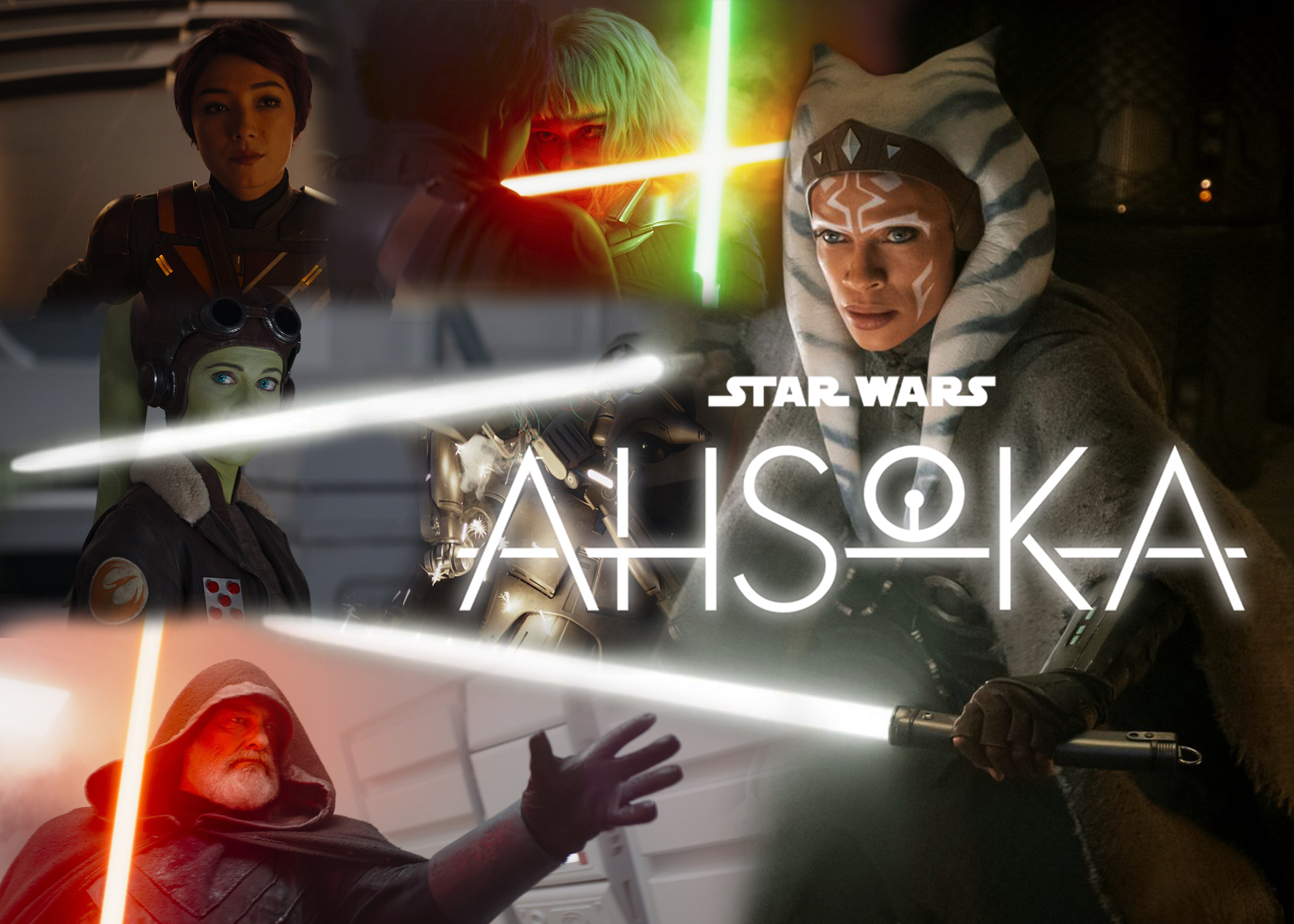Review | ‘Ahsoka’ showcases everything that makes ‘Star Wars’ so exciting
After four episodes, it’s clear that Star Wars executive Dave Filoni has created a series that harkens back to the styles of the franchise’s past. Photo collage by SIMRAH AHMAD, Staff Photographer
Spoiler alert: This article contains spoilers for the first four episodes of “Ahsoka.”
Much like the galaxy portrayed in the iconic series, the “Star Wars” franchise is massive.
Considering the series’ film and television pieces alone, the franchise comprises three film trilogies, two spin-off films and multiple animated and live-action series. While mainly focusing on similar points of action within the franchise’s lore, each trilogy and series brings different characters and styles to the forefront of their respective storylines.
Amidst the multitude of “Star Wars” media available, director, producer and writer Dave Filoni’s “Ahsoka” premiered on Disney+ with two episodes on Aug. 22. New episodes will premiere weekly through Oct. 3. Filoni’s work here, as with the majority of his work on the franchise — including his work on “Star Wars: The Clone Wars” — is fantastic.
Set after the titular character’s appearances in “The Mandalorian” and “The Book of Boba Fett,” the show follows Ahsoka Tano (Rosario Dawson) searching for lost allies. She looks for Jedi Ezra Bridger (Eman Esfandi) while regrouping with friends from “Star Wars: Rebels,” including New Republic General Hera Syndulla (Mary Elizabeth Winstead) and her former apprentice Sabine Wren (Natasha Liu Bordizzo).
The series is Ahsoka’s by title, but Filoni makes “Ahsoka” feel like it has an ensemble focus. Hera and Sabine both encounter conflicts and have their own desires as characters. For the majority of the series’ first four episodes (all that has been released as of this review), “Ahsoka” feels more like a continuation of “Star Wars: Rebels” than it does a study of the character herself. However, the ensemble focus is not a criticism. It’s enjoyable to see a “Star Wars” story designed with multiple characters taking center stage, each with their own character arcs.
Just as the galaxy’s heroes want Bridger back, its enemies desire Thrawn, the Grand Admiral of the Empire who disappeared with Ezra. Opposing Ahsoka’s team are a group led by Morgan Elsbeth (Diana Lee Inosanto). At her command are Baylan Skoll (Ray Stevenson), Shin Hati (Ivanna Sakhno) and Marrok (Paul Darnell). All three give fantastic performances as the central antagonists. Stevenson portrays Skoll’s wisdom and maturity excellently, setting the character apart from his animalistic peers. Sakhno displays a rage that makes Hati a terrifying opponent to our heroes and Darnell’s movements make Marrok, a character clad entirely in armor, always seem mysterious and intriguing.
Praise should also go to Dawson, herself. She portrays the character in live-action after Ashley Eckstein voiced her animated iteration, and her performance echoes Eckstein’s in more ways than one. Certain inflections in Dawson’s voice allow her to sound like Eckstein, and her performance illustrates Ahsoka’s transition from the eager, brash Jedi padawan to the calmer rogue.
That youthful defiance isn’t completely gone, though. In a duel with Skoll, Ahsoka becomes somewhat rageful and swift, much like her animated iteration. One arc in “Star Wars: The Clone Wars” revolved around Ahsoka being framed for a murder — one that ultimately led to her disillusionment with the Jedi Order. For the remainder of that series, she operated as a rogue fighter, acting friendly with her former acquaintances in the Order but not necessarily succumbing to their regiments.
The scene from “Ahsoka” is mentioned to show the series’ consciousness of and allusion to what has come before it. Ahsoka may seem like a different, fully grown-up character, but she still builds off of what fans watched her experience in prior appearances. Her non-Jedi mannerisms being on display illustrates that.
Much of “Ahsoka” jumps straight into elements of the franchise’s past, including the aspect that is most exciting: exhilarating science-fiction action. Gone is the cliché of teasing a confrontation between a series’ main hero and villain, only to hold off their meeting until a finale. In three of the series’ first four episodes, lightsaber duels constantly entertain.
Director of Photography Eric Steelberg displays beautiful shots of New Republic fleets that echo the portrayal of spaceships from the series’ original trilogy. Lighting, too, is of note here. While the majority of the episodes’ props and set pieces look akin to those found in other films and series of contemporary “Star Wars” content, certain lighting choices in episodes remind one of the set pieces of the prequel trilogy. This illustrates that no matter what era of “Star Wars” you enjoy, there is something for everyone in this series.
While discussing lighting, every scene in the series — no matter its location or time of day — feels bright and entertaining. Scenes of simple action are always elevated by well-constructed visual presentations, and “Ahsoka” does not falter on that front. The series’ use of lightsabers stands out. The weapons seem incredibly striking, as if Filoni and his collaborators recognized their iconicity to the franchise and chose to shoot them so that they are imbued with majesticness.
Referential, too, is Kevin Kiner’s music. Composing for the series after working on much of the franchise’s animated media, Kiner writes music akin to John Williams’ leitmotifs from the original trilogy. Viewers have a sense that they are watching “Star Wars: Episode IV - A New Hope,” and it is again truly what makes “Ahsoka” great — there is a love for what kicked off the franchise.
The next episode will come out on Sept. 12, with the series set to end on Oct. 3.


